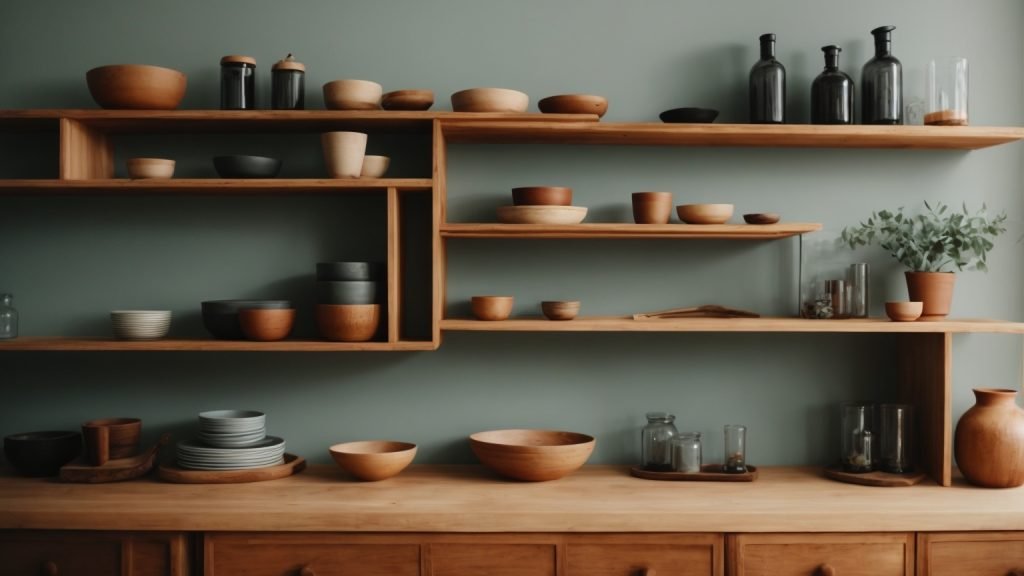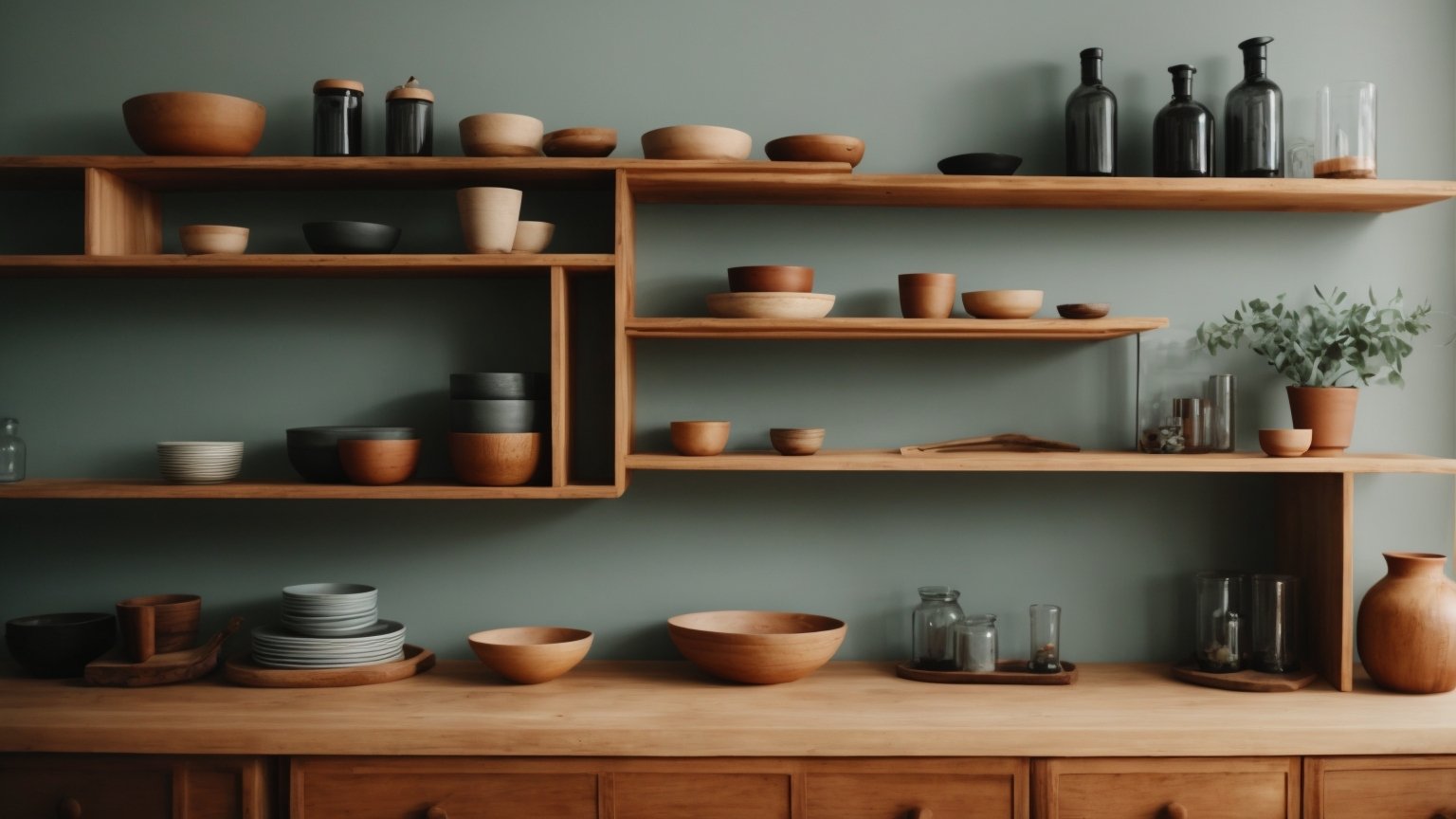Are you looking for a way to add some extra storage space to your home? Wooden shelves are a great solution that can be customized to fit your specific needs and style. Whether you’re looking to organize your kitchen, display your favorite books, or create a unique piece of decor, building your own wooden shelves can be a fun and rewarding project.
Before you get started, it’s important to consider a few key factors. First, you’ll need to decide on the type of wood you want to use. Softwood boards are a popular choice for their affordability and versatility, while hardwoods like oak and maple offer a more durable and elegant option. You’ll also need to determine the size and shape of your shelves, as well as the method of installation. Will you be using brackets, building floating shelves, or incorporating a built-in design? With these factors in mind, let’s dive into the steps involved in making your own wooden shelves.
Understanding the Basics of Woodworking

Woodworking is an art that requires patience, skill, and knowledge. Whether you are a beginner or an experienced woodworker, it is essential to understand the basics of woodworking before starting any project. In this section, we will cover the types of wood and safety measures you need to know before making wooden shelves.
Types of Wood
Before starting any woodworking project, you need to choose the right type of wood. The type of wood you choose will depend on the project you want to undertake. Here are some common types of wood used in woodworking:
| Wood Type | Characteristics |
|---|---|
| Pine | Softwood, easy to work with, affordable |
| Oak | Hardwood, durable, expensive |
| Maple | Hardwood, fine texture, easy to work with |
| Cherry | Hardwood, beautiful grain, medium hardness |
When selecting wood, consider the color, grain pattern, and texture. You can also choose between rough-cut and surfaced wood. Rough-cut wood has a rough texture and requires more work to smooth it out. Surfaced wood has a smooth finish and is ready to use.
Safety Measures
Woodworking involves the use of sharp tools and machinery, making it essential to take safety measures. Here are some safety measures you should follow when making wooden shelves:
- Wear safety goggles to protect your eyes from flying debris
- Use ear protection when using loud machinery
- Keep your work area clean and free of clutter
- Use sharp tools to prevent accidents
- Follow the manufacturer’s instructions when using machinery
- Keep your fingers away from blades and cutters
- Use a dust mask to protect your lungs from sawdust
By following these safety measures, you can reduce the risk of accidents and injuries while woodworking.
Now that you understand the basics of woodworking, you can start making your wooden shelves. Remember to choose the right type of wood and follow safety measures to ensure a successful project.
Gathering Your Materials
Before you start building your wooden shelves, you need to gather all the necessary materials. This includes choosing the right wood and selecting the proper tools.
Choosing Your Wood
When choosing the wood for your shelves, you need to consider the weight of the items you will be placing on them, as well as the overall aesthetic you are going for. Some common types of wood used for shelves include pine, oak, and maple.
Pine is a softwood that is easy to work with and has a rustic look. Oak is a hardwood that is durable and has a more traditional appearance. Maple is another hardwood that is strong and has a light, uniform color.
Make sure to choose wood that is straight and free of knots, cracks, or other defects that could weaken the shelf.
Selecting Your Tools
To build your wooden shelves, you will need a variety of tools. Some of the essential tools include:
- Circular saw or table saw
- Drill and drill bits
- Screws and nails
- Wood glue
- Sandpaper
- Measuring tape
- Level
Depending on the design of your shelves, you may also need a router, jigsaw, or other specialty tools.
Make sure to have all the necessary tools on hand before you start building to avoid delays or frustration during the process.
By choosing the right wood and selecting the proper tools, you can ensure that your wooden shelves are sturdy, functional, and visually appealing.
Designing Your Wooden Shelves

Before you start building your wooden shelves, it’s important to design them first. This will help you determine the size and shape of your shelves, as well as the materials you’ll need. Here are some tips on how to design your wooden shelves:
Determining the Size
The first step in designing your wooden shelves is to determine the size you need. Consider the space where you’ll be installing the shelves and measure the area where you want to place them. Make sure to take into account any obstacles or fixtures that may affect the size of your shelves.
Once you have the measurements, decide on the depth and height of your shelves. The depth should be at least 10 inches to accommodate most standard items, while the height will depend on your preference and the space available.
Sketching the Design
After determining the size of your shelves, it’s time to sketch the design. This will help you visualize how your shelves will look and give you an idea of the materials you’ll need.
Start by sketching the overall shape of your shelves. You can choose between a simple rectangular design or a more complex shape, depending on your preference. Then, decide on the number of shelves you want and their placement.
Next, sketch the details of your shelves, such as the edges and corners. You can choose between a rounded or square edge, depending on the style you want to achieve. You can also add decorative elements, such as brackets or trim, to enhance the look of your shelves.
Finally, make a list of the materials you’ll need, including the type of wood, screws, brackets, and any other hardware. This will help you stay organized and ensure that you have everything you need before you start building your shelves.
By following these tips, you can design wooden shelves that are both functional and stylish. With a little planning and creativity, you can create shelves that will enhance the look of any room in your home.
Preparing the Wood
Before you start building your wooden shelves, you need to prepare the wood. This involves cutting the wood to the right size and sanding it to ensure a smooth finish. Here’s how to do it:
Cutting the Wood
The first step in preparing the wood is to cut it to the right size. You can use a saw or a miter saw to do this. Make sure you measure the wood carefully before cutting it to avoid any mistakes.
If you’re using pre-cut wood, you can skip this step. However, if you’re cutting your own wood, you’ll need to measure it carefully and mark it before cutting. A table saw can also be used to cut the wood, but it is not necessary.
Sanding the Wood
Once you’ve cut the wood to the right size, the next step is to sand it. Sanding the wood will ensure that it is smooth and free of any rough edges or splinters. You can use a palm sander or sanding blocks to do this.
Start with a coarse sandpaper and work your way up to a finer grit. This will help to remove any rough spots and create a smooth surface. Be sure to sand both sides of the wood and the edges as well.
After sanding, wipe the wood down with a damp cloth to remove any sawdust. You can also apply a wood conditioner to the wood to help it accept the stain or paint better.
By following these steps, you can prepare your wood for building your shelves. With the wood cut to the right size and sanded to a smooth finish, you’ll be ready to move on to the next step in building your shelves.
Assembling the Shelves
Once you have cut your wooden boards to the desired length, it’s time to assemble your shelves. In this section, we will guide you through the process of attaching the pieces and securing them with screws.
Attaching the Pieces
To begin, lay out your cut wooden boards on a flat surface, making sure they are aligned correctly. Next, take your drill and create pilot holes in each of the boards where they will connect. Pilot holes will make it easier to attach the boards and prevent the wood from splitting.
Once you have created your pilot holes, apply a thin layer of wood glue to the edges of the boards that will be joined together. Then, using clamps, press the boards together, making sure they are flush and even. Allow the glue to dry completely before moving on to the next step.
Securing with Screws
Now that your boards are securely glued together, it’s time to add screws to reinforce the joints. Select screws that are the appropriate length for the thickness of your boards. You don’t want screws that are too long or too short.
Insert the screws into the pilot holes you created earlier, making sure they are driven in straight and flush with the surface of the wood. Be careful not to overtighten the screws, as this can cause the wood to split.
Repeat this process for each joint until all of your shelves are assembled. Once you have finished, you can sand the edges of the shelves to create a smooth finish.
Congratulations, you have successfully assembled your wooden shelves!
Finishing Touches
Once you have built your wooden shelves, it’s time to add the finishing touches. This will not only give the shelves a professional look but also protect them from damage. In this section, we will cover two important sub-sections: Applying Wood Stain and Adding a Protective Coat.
Applying Wood Stain
Wood stain is a great way to enhance the natural beauty of wood while also protecting it from damage. Here are the steps to apply wood stain:
- Sand the surface of the wood to make it smooth.
- Clean the surface with a damp cloth to remove any dust or debris.
- Apply the wood stain using a brush or a cloth. Make sure to follow the manufacturer’s instructions for the specific product you are using.
- Let the stain sit for the recommended amount of time before wiping off any excess with a clean cloth.
- Allow the stain to dry completely before applying a protective coat.
Adding a Protective Coat
Adding a protective coat will help keep your wooden shelves looking new and prevent damage from scratches, spills, and other wear and tear. Here are the steps to add a protective coat:
- Choose the type of protective coat you want to use. Polyurethane, varnish, and wax are all popular options.
- If you are using polyurethane or varnish, apply it with a brush or a roller. If you are using wax, use a clean cloth.
- Apply the first coat and let it dry completely before adding another coat. Make sure to follow the manufacturer’s instructions for the specific product you are using.
- Once you have applied the recommended number of coats, let the protective coat dry completely before using the shelves.
By following these steps, you can add the finishing touches to your wooden shelves and protect them from damage.
Installing the Shelves
Once you have built your wooden shelves, it’s time to install them. Here are some tips to help you get it right.
Choosing the Right Location
Before you start installing your shelves, think carefully about where you want to put them. Consider the following factors:
- Weight Capacity: Make sure the wall can support the weight of the shelves and anything you plan to put on them.
- Accessibility: Choose a location that is easy to access and won’t get in the way of other activities.
- Style: Consider the overall look and feel of the room and choose a location that complements it.
Mounting on the Wall
When you’re ready to mount your shelves, follow these steps:
- Use a stud finder to locate the studs in the wall. Mark the location of the studs with a pencil.
- Hold the shelf against the wall at the desired height. Use a level to make sure it is straight.
- Use a drill to make pilot holes through the shelf and into the wall studs.
- Insert screws into the pilot holes and tighten them with a screwdriver.
- Repeat the process for each shelf.
Remember to leave enough space between shelves to accommodate the items you plan to store on them. With these tips, you’ll be able to install your wooden shelves with ease and confidence.
